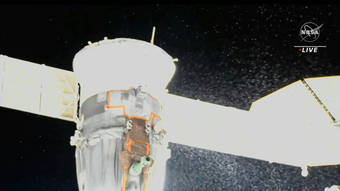Roscosmos, the Russian space agency, informed this Wednesday (11) that the soyuz capsulecurrently attached to International Space Station and which was the victim of a refrigerated gas leak last month, is expected to return to Earth unmanned. The gas has the function of maintaining the mild temperature inside the capsule.
“Experts have concluded that the Soyuz M-22 must return to Earth unmanned,” said Roscosmos, who confirmed in a statement that the leak was caused by the “impact” of a small cosmic object responsible from a hole less than 1mm in diameter.
Three people – Russians Sergei Prokopyev and Dmitry Petelin and American Frank Rubio – were aboard the Russian Soyuz spacecraft that arrived at the International Space Station on Sept. 21.
With today’s decision they will share the space with four other astronauts who were already there: Russian Anna Kikina, Americans Nicole Mann and Josh Cassada and Japanese Koichi Wakata. That was until Russia sent another spacecraft to rescue the three astronauts.
The four are part of the crew of Crew-5, which arrived on the ISS in October 2022, aboard a spacecraft of the private company SpaceX, whose services are contracted by NASA.
astronaut rescue
Today the Russia has announced that it will send another spacecraft, Soyuz-23 to the International Space Station to rescue the three astronauts. This capsule will travel without passengers as the space will be occupied by the crew temporarily in space.
However, this will only happen on February 20th. Despite the deadline, the take-off represents an advance, since the initial forecast was to leave only on March 16, 2023.
Previously, NASA was analyzing the use of the SpaceX Dragon spacecraft as a rescue alternative after the Russian capsule suffered a coolant leak while docked at the orbital laboratory.
Together, NASA and Roscosmos further investigated the cause of the drilling. The Soyuz spacecraft was supposed to bring the team of two cosmonauts and a US astronaut back to Earth earlier this year.
But the December 14 leak, which depleted the Soyuz of a vital fluid used to regulate the temperature of the crew cabin, destabilized the Russian space capsule’s routines.
Faulty Soyuz capsule
In December, space agencies in Russia and the United States were assessing the severity of the leak in the cooling system of the Russian spacecraft docked with the International Space Station (ISS). Until then, the cause of the accident was unknown.
The Soyuz MS-22 spacecraft has been docked with the ISS since it carried Russian cosmonauts Sergei Prokopyev and Dmitry Petelin in September 2022, as well as US astronaut Frank Rubio.
At the time of the crash, the two Russians were preparing for a spacewalk when the warning system went off, indicating a drop in pressure in the spacecraft’s cooling system, according to a statement by Russia’s space agency Roscosmos.
In the images released by NASA it was already possible to clearly see a jet of white particles escaping into space, which would be the refrigerant.
“The cause of the leak could be a micrometeorite,” said Sergei Krikalev, director of human spaceflight at Roscosmos at the time, according to a statement released by Russia’s Tass news agency.
The liquid was leaking from the rear of the spacecraft, which was docked on the Russian segment of the ISS. The leak stopped on its own shortly after.
The spacewalk has been canceled “to allow time to evaluate fluids and potential impacts on the integrity of the Soyuz spacecraft,” NASA said in a statement.
“Crew members aboard the Space Station are safe and in no danger during the leak,” the agency added.
Alternative Redemption
The two Russian cosmonauts and the American astronaut arrived at the ISS on Sept. 21 aboard a Russian rocket launched from Kazakhstan.
According to the program, they should use that same ship to return to Earth after six months, at the end of its mission, in March 2023. However, given the damage caused to the ship, the possible “backup” solutions, which were not officially detailed, they already planned to ship a new vehicle.
The exchange of a Russian cosmonaut to fly aboard an American spacecraft and vice versa has been expected for some time and has materialized despite the tensions between the two countries.
The ISS is one of the few fields of cooperation left between Moscow and Washington since the beginning of the Russian invasion of Ukraine, launched on February 24, and the Western response with the imposition of economic sanctions.
The orbital platform was launched in 1998, in a moment of cooperation between the United States and Russia, after the space race in which the two were involved during the Cold War years.
